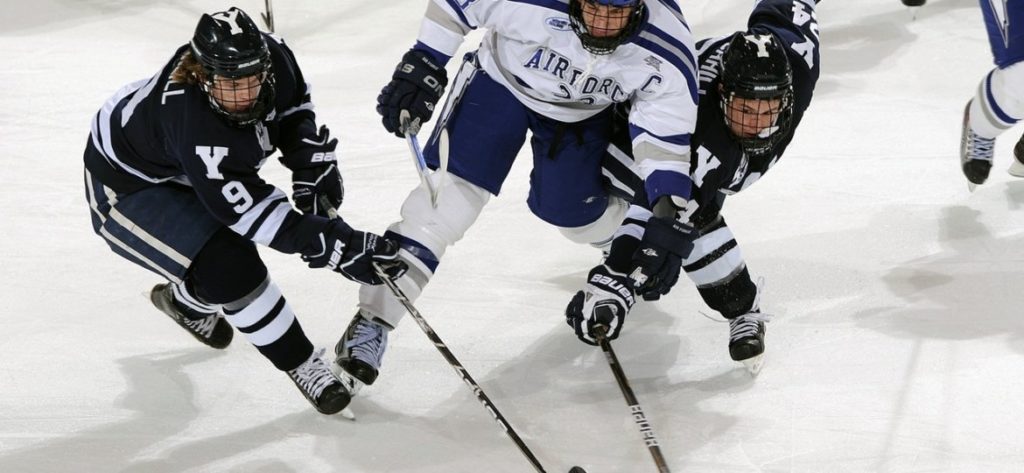
Dr. Barry L. Seiller
12/2001: Stops & Starts, American Hockey Coaches Association Guest Article
Most hockey coaches recognize the significant role that vision and visual skills have on their players' performance. Many of these coaches and trainers have searched for a method to improve each player's visual skills and abilities knowing that "if you can't see the puck you can't shoot, pass or save it."
There can be no doubt that an athlete's visual skills (good or bad) have a significant impact (positive or negative) on their performance. The more time we spend working with athletes, the more impressed we are with our findings. At Visual Fitness, we have demonstrated that visual skills like all physical skills can be taught, trained, practiced and perfected. We're not talking just 20/20 eyesight, which is essential, but how athletes use the information received tom the eyes.
Most players are similar in size, speed, and conditioning and all have learned the basic techniques, but we have found one of the critical differences between athletes is their visual skills and visual abilities. Chances are that every athlete can improve in one or more visual skill areas, i.e. visual acuity, visual recognition skills, depth perception, tracking or focusing abilities or even eyesight. These skills are interrelated and when lumped together, refine hand eye-body coordination and help a player "see the ice"
What are those inter-related visual skills and abilities that are important in hockey?
Good eyesight is the cornerstone of all the visual abilities and the easiest to correct with contact lenses or, now, Laser Vision Correction. If it is reduced, all the other visual skills and abilities will be weakened.
Knowing the exact position or the net and goalie position.
Excellent depth perception is essential to aid in judgment of position of puck in relation to players and position on ice.
Eye Flexibility allows the player to move their eyes in and out more quickly and accurately.
Visual recognition is used to help remember where teammate and opposing players frequently position themselves on ice.
The skill to follow puck and player movement.
Mike Smith, the progressive General Manager of the Chicago Blackhawks, recognizes the importance of these visual skills. Mike has long known that the Russians had developed testing and training techniques years ago, which had given their players a competitive advantage over the rest of the world. He has asked VFI to develop a program for the Blackhawks taking into account the special concerns of the fact that his team members are constantly on the move during the season and are based all over the world. Smith says,
I believe the development of visual skills is an area that can help our players. Two areas in particular, depth perception and hand-eye coordination can be vastly improved. We have found our players to be quite receptive towards it.
The Visual Fitness Institute (VFI) was founded in 1989, with the objective of testing, training, and improving athletes' visual skill levels through the use of the most technologically advanced vision training techniques and equipment. Only a few facilities like VFI exist in this country. Programs are designed to provide visual skills assessments and training for universities, Olympic and amateur and professional players. Using the Visual Fitness Institute's testing protocol, each athlete's visual motor skills are measured and recorded. If appropriate, a personalized vision-training program is designed for each athlete. The recommendations we provide, eyesight improvement, and visual skill training, will impact their performance.
Until recently the program were facility based, either at VFI's home office in Illinois or at satellite facilities such as the ones we have established at the USOC facility in Lake Placid NY for the U.S. Luge, Bobsled & Skeleton Teams. We also were able to evaluate the U.S. Ski and Snowboard Teams and the U.S. Women's Hockey Team. There is the first of its kind University program at Georgia Tech in Atlanta, utilized by all student athletes. The Cleveland Indians and Milwaukee Brewers also have facilities for their minor league players.
Frequently, the facilities have purchased vision-training equipment and have designated a staff member who is educated on how to deliver vision performance training sessions. The program allows for existing relationships with local eye care practitioners to remain in place; and is tailored to the specific needs and logistics of each organization. However, because of budget constraints and access availability of both the organization's staff and the VFI staff, an alternative has been developed.
VFI has developed the Visual Edge Vision Performance Trainer. Available in January 2002, it is a computer based CD Rom capable of carrying out the visual assessment and training of the athlete in their home, dorm, or training facility. This disc will allow the economical implementation that similar programs of our larger clients. With increase access to this technology and services VFI, expects vision performance training to take its place as another component in a complete training program.
Athletes, coaches and trainers, have long recognized the benefits of good nutrition, aerobic conditioning, weight training, and quality equipment, until recently, very few understood the importance of visual skill training. Today, no athlete who strives for excellence can ignore the visual system as a vital component of his or her training.
Further Information can be found at www.vizualedge.com and www.visualfitness.com.